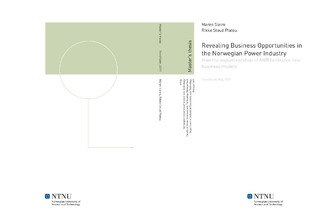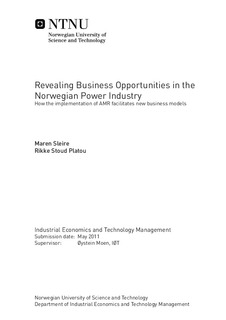| dc.description.abstract | This thesis aims to map out the current state of the Norwegian power industry and reveal opportunities that can serve as a fundament for the formation of new business models in the industry post AMR implementation.Demand side management (DSM) arouse to include end customers and give them incentives for having a power consumption pattern which also benefits the power system. Market structure; lack of ICT infrastructure and understanding of the solutions; costs and competitiveness, as well as the lack of incentives are currently some of the most critical barriers to DSM implementation. However, the forthcoming establishment of a smarter transmission grid is expected to easier facilitate DSM actions. A smart grid facilitates transmission of information in addition to power, and is hence more intelligent than today s grid as it can integrate the behavior of all connected users. A smart grid is not one single installation, but consists of several components, of which automatic meter reading (AMR) is one. The drivers for implementing a smarter grid in Norway differ from the prevailing European drivers. In Norway, the progress towards a smarter grid is driven by the desire to reduce peak loads and create a secure power system which benefits the end customer. Implementation of AMR has been adopted in Norway, although the specific functionalities and responsibilities are not yet entirely determined. In addition to AMR implementation, a common Nordic end user market is also expected within the coming years. We expect the supplier centric model (SCM) to become the chosen market model. This involves a single contact point for the end customer, so that the supplier will handle most customer specific issues. AMR is expected to facilitate innovation opportunities that potentially can lead to a disruptive change of the industry. Dependent on current position, industry actors must determine whether to act as a first-mover or a fast second when taking positions in the future industry. End customer support is decisive for diffusion of the additional technological functionalities AMR can provide. Four key subjects for examining fundamental conditions for the formation of new business models in this market concern industry changes; a possible redistribution of responsibilities and roles; mapping of market forces and last but not least revealing unrealized value in the value chain. We find that a redistribution of roles in the electrical power market is probable, and that the actor most exposed to changes and new industry actors are the power suppliers. An assessment of market forces in the industry after AMR implementation shows that the end customer has the most power and is of great significance for the development of the industry. We reveal unrealized value in customer relations, customer flexibility and metering data. AMR has disruptive characteristics, and competitive companies spotting disruptive change in advance can choose between defending against the threat and utilizing this change. Due to uncertainty, companies are in danger of underestimating the potential impact of future disruptive changes. Existing power suppliers should enter into alliances to obtain future required qualities for success, such as flexibility, ICT knowledge and innovation skills. In order to achieve desired diffusion of new innovations, companies should be aware of the importance of mapping customers behavior and willingness to adopt new solutions. The revealed unrealized value can take different expressions in the future market. Metering data facilitate development of additional solutions on the AMR platform. The customer flexibility is extremely valuable but currently difficult to access. Transactions of flexibility from end customers can follow four different models, dependent on who is buying flexibility. Three different future scenarios for customer relations are predicted; fully separated activities, concentrated activity bundling and fragmented activity bundling, dependent on whether the customer relates to one or more power suppliers and service providers. We expect an industry revolution which will favor companies which are close to the customer and which are flexible and possess competencies within innovation and ICT. Accessing the three sources of unrealized value, which are all customer related, can give competitive advantage and serve as a fundament for the formation of new business models in the Norwegian power industry post AMR implementation. | nb_NO |

